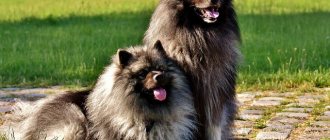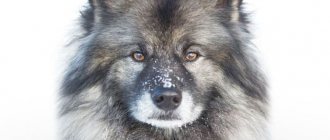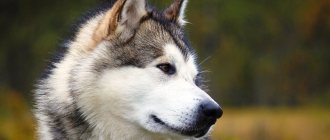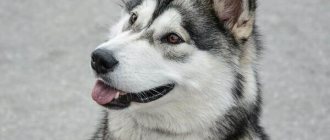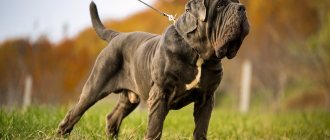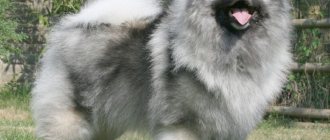The Keeshond or Wolfspitz is an ancient breed that originated in Northern Europe, where Germany and the Netherlands are located. The dog is the largest representative of the Spitz family.
Experts from the International Canine Organization predict great prospects for its further development and reproduction. Attentive and sensitive Spitz dogs have retained their appearance through the centuries and look like their distant ancestors.
Story
The first mention of the Wolfspitz dates back to the 16th century. In those days, the European nobility was actively interested in Spitz dogs and developed new colors and species. The breed of wolf dogs was intended for security activities.
Due to the fact that they were often kept on boats and ships, they were nicknamed barge dogs.
In the 18th century, there was an uprising in Holland against the ruler led by Cornelius de Guislar. Everywhere he was accompanied by a large Spitz of the wolf breed, which became the emblem of the conspirators.
After the failure of the rebellion, they began to actively get rid of these animals, as a symbol of loss, and the number of individuals rapidly decreased. The remaining dogs served the fishermen and barge owners with whom they sailed to Germany. Here the breed was given a second name - Wolfspitz.
Restoration of the species began in 1920. The breeder was Baroness von Hunderburk, who made the Wolfspitz popular throughout Europe.
Origin story
Wolfspitz is the oldest breed. It originates from Stone Age peat dogs. It was recognized as a separate species in Germany. The name Keeshond was given to her in Holland. One of the functions was the protection of barges (that’s why the breed is also called barge).
The breed has been bred since the 16th century, and the dogs spread throughout Europe. Black and brown Spitz guarded grape plantations, white was popular in the provinces. The ancestors of the breed were not of interest to dog breeders, as they did not have an elegant appearance, endurance and strength. For a long time, dogs were perceived as watchmen and shepherds, nothing more. The modern Keeshond was more adaptable, healthier, and trainable.
The Wolfspitz appeared in Russia only in the 20th century. The dog has a wolf color, it was bred as a watchman (to protect houses, livestock, boats). Throughout history, the breed's description and appearance have remained almost unchanged. The Wolfspitz is very similar to the Pomeranian and German Spitz.
Currently, the Keeshond is recognized as an intrabreed type of Wolfspitz. The dogs share a common history, but the Wolfspitz is larger and more energetic than the Keeshond.
Description
The dogs are distinguished by their large shapes and are recognized as the largest Spitz in the world. A characteristic feature of the Wolfspitz is its thick gray coat and fluffiness. This breed is one of the most ancient, but the dogs’ appearance and behavior have not changed. They are physically developed, tireless, dexterous.
The main purpose of Wolfspitz dogs is to protect household facilities and housing.
With proper upbringing and training, they develop the skills of watchdogs that warn of strangers entering the territory.
Wolfspitz are not intended for the role of bodyguards, they are unable to protect the owner or attack the enemy with the aim of detaining them. The breed is suitable for active people and athletes due to its ability to withstand loads.
Keeshond character
I think it is extremely important when choosing a breed to find out why this breed was bred - this determines the character of the dog. And if huskies, for example, were bred to run, then the Keeshond was bred to be close to people. They were always companions and never “worked” as guards or hunters.
The Keeshond is an unusually people-oriented dog. And for her, contact with a person is extremely important. Therefore, if they call me and ask for a dog “in the private sector, in an enclosure,” my first question is: how long will you see your dog? If there is not enough communication, the dog will grow up nervous and stupid, and will rush towards all passers-by and yell.
It is extremely important to socialize your Keeshond, especially under 1 year of age. I'm not talking about being with your dog 24/7, but it is important to make time for your dog. However, this applies to any breed.
Breeder's observations: Keeshond puppies, like almost all puppies, love to chew on something. And until we were 1 year old, we experienced this “wonderful” period of gnawing. Moreover, my dogs began to chew at an older age than “accepted” - closer to 7 months, although it would seem that the teeth had already changed. But after about 1.5 months it went away.
Keeshonds are very cheerful and positive, they love to play and indulge. It is not without reason that one of the unspoken names of the breeds is “Smiling Dutchman”.
Not being hunters, they don't chase birds (unless I need him to chase them), cats or other dogs. And if this happens, they are very easy to control and respond to calls.
Breeder's observations: Keeshonds are great with children. My eldest dog is 10 years old, and my daughter is 8. Naturally, when the baby crawled, the first thing he did was crawl to the dog and count his teeth with his finger. Sonya, our dog, just turned away. Sonya endured being dressed - in winter, with the batteries on, they put on a hat and wrapped her in a warm blanket. So Keeshonds have angelic patience.
Breed standard
According to the standards of the International Canine Federation, the dog's height should be 49 cm +/- 6 cm. Weight ranges from 18-21 kg. Wolfspitz females have smaller dimensions.
Parameters are rarely taken into account during assessment; the greatest importance is given to the harmony of the physique.
Expert opinion
Anna Abramenko
An avid dog lover. Experience in veterinary medicine since 2009.
Ask a Question
The dog should not have heavy or excessively thin bones; medium strength is preferred. The ideal size, as a rule, is formed in representatives of the breed after 2 years.
The body of the Wolfspitz is square with a wedge-shaped head. The neck corresponds to the body, surrounded by a lush, thick mane. The lumbar region of the back is wide and strong. The chest is concave and developed.
The muzzle is short, narrowed. The eyes are almond-shaped, the color is dark brown. Spitz ears are triangular and erect. The paws are straight and parallel to each other.
Breed Features
These animals were bred several centuries ago, but received official recognition from the International Canine Association only at the beginning of the twentieth century. These dogs are excellent hunters, they are very hardy and fast.
Due to their small size , they successfully pull foxes and badgers out of their holes during the hunt.
The Border Terrier is the smallest of the working terriers. When a male grows up, he reaches from 28 to 34 cm at the withers and weighs from 6 to 7 kg. A female is up to 26 cm at the withers and weighs from 5 to 6.5 kg.
The dog has several varieties of color , these include the following:
- ginger;
- wheat;
- pepper and salt;
- reddish blue.
Hunting qualities
Borders are often used in hunting in conjunction with hounds to quickly obtain trophies. Among those who prefer to catch game using dogs, representatives of this breed are highly valued.
The hunting qualities of borders include the following.
- The length of the legs in relation to the body is quite long, which allows the dog to run very quickly.
- Small size, making it possible to freely get into holes.
- Wool cover that protects from cold and rain.
- A heightened sense of pack, thanks to which terriers are used in group hunting.
- Speed of reaction and movement, facilitating lightning-fast assessment of the situation and making a decision to attack the game.
Behavior and skills
Wolfspitz dogs are attentive, energetic and receptive. Any changes in the house or in the protected area are responded to with a loud bark. They are wary of strangers and warn about their visit.
The animal is unobtrusive. If he sees that the owner is busy, he steps aside and does not interfere. This is a companion who empathizes with a person, feeling the mood.
Dutch Wolf Spitz guarded property, which developed distrust and suspicion at the genetic level in the breed. They guard their trusted territory well and do not let strangers through.
The breed is actively used in guard duty and search activities. She has strong intuition and kindness - qualities that help people in difficult psychological conditions recover.
Breed traits
Breed traits (on a 5-point scale)
| Keeshond (Dutch Wolf Spitz) | |||
| Activity | in the house | 2.4 | |
| on the street | 3.2 | ||
| Obedience | training | 4.1 | |
| strangers | 3.8 | ||
| Domination | in family | 1.7 | |
| over dogs | 2.1 | ||
| Defending your territory | from people | 1.9 | |
| from dogs | 2.2 | ||
| Sociability | in family | 4.8 | |
| with strangers | 4 | ||
| with dogs | 3.4 | ||
| Concentration | in family | 1.2 | |
| in front of strangers | 1.6 | ||
| with dogs | 2 | ||
| Aggressiveness | in family | 1 | |
| to strangers | 1.4 | ||
| to the dogs | 1.9 | ||
| to cats | 1.5 | ||
| Family behavior | calmness | 4.8 | |
| demand for affection | 4.7 | ||
| excitability | 3.9 | ||
| playfulness | 3.8 | ||
| excessive barking | 3.1 | ||
| behavioral breakdowns | 1.8 | ||
| Tolerance for children | up to 4 years | 4 | |
| over 4 years old | 4.4 | ||
| Institutional use | watchman | 4.5 | |
| bodyguard | 1.7 | ||
This breed is often compared to the following dog breeds: Samoyed, Cavalier King Charles Spaniel, Shiba Inu, Miniature Schnauzer, Pekingese.
Photos of Keeshonds:
Character and appearance
Wolfspitz are smart dogs, they clearly know their responsibilities and place in the house. They easily become attached to the family, but obey one master. Active, love to play, sociable.
Expert opinion
Anna Abramenko
An avid dog lover. Experience in veterinary medicine since 2009.
Ask a Question
The breed's fault is aggressiveness.
If desired, the Spitz can be taught numerous commands and tricks. The dog is friendly with children and pets.
The main advantage of the Spitz's appearance is its wolf coloring, covering thick, long hair that rises to form a mane and fluffy pants. The shades of the Wolfspitz's coat may vary, but are always gray.
The dog's muzzle, ears and tail stand out against the general background due to its deep black color. The undercoat is silvery, light or creamy, which blends perfectly with the dark tips.
Description of the breed
The Wolfspitz is a medium-sized dog with a harmonious and very compact build. The Spitz Keeshond is the largest representative of the German Spitz breed.
The Wolfspitz's back is not long, slightly lowered towards the croup. The stomach is tucked, and the chest is strong and high. Paws are straight, short, with small round paws, proportional. Fluffy tail in a ring. The muzzle is wedge-shaped, tapering towards the nose. The ears are triangular, small, erect, and set wide apart. Nose and lips are black. The eyes are oval, medium size, dark brown.
The hair is long all over the body, with the exception of the head. The long hair on the neck forms a kind of mane. The coat color is very similar to that of a wolf, as evidenced by the characteristic name; it has white, gray, black or red and brown shades.
Breed standard
As mentioned earlier, the Wolfspitz has a harmonious body structure. It is medium in size in relation to all types of dogs, and large in relation to other types of German Spitz. Spitz dogs with white coloring are usually the largest.
The height of an adult male Keeshond ranges from 43-55 centimeters; the female’s height is no different, the same 43-55. The weight of an adult dog is the same for males and females; it corresponds to height and ranges from 25 to 30 kilograms.
Character and temperament
The Keeshond is a very active dog. With age he becomes calmer, but does not lose his funny liveliness. Famous for its devotion, attentiveness and receptivity. He also has good intellectual abilities. She has good intuition and understands what a person wants from her and what she shouldn’t do, so she rarely gets in the way when the owner has no time for her.
It treats strangers and animals with distrust and greets them on its territory with a loud bark, which is not surprising, because in the past it was known as a guard dog. But at the same time it does not have a pronounced hunting instinct and a tendency to aggression. But he usually gets along well with his people and other pets, without any problems.
Has attachment to his home and owner, does not strive to break free and have an independent existence. Wolfspitz dogs are often called upon to help people with psychological problems because of their intuition, friendliness and cheerfulness.
Health and life expectancy
Keeshonds are very healthy dogs, they have no breed diseases, and they live for quite a long period. And the life expectancy is 13-16 years, and this is not always the limit; there are also long-lived Wolfspitzes. Among the health problems of Wolfspitz dogs, the following can be identified:
- epilepsy;
- heart disease (in older dogs);
- problems with the thyroid gland;
- problems with the adrenal glands.
Disadvantages of the breed
No matter how many advantages and wonderful features the Wolfspitz has, it also has its disadvantages, and they should also be taken into account. The Wolfspitz is unlikely to please people who are accustomed to and value peace and quiet, because it has a loud and ringing bark and is very active. And also thick and long hair requires special careful care, which not all owners like to do.
Read The whole truth about the Coton de Tulear: characteristics of the Madagascar Bichon
Education and training
Wolfspitz are very smart, they learn easily thanks to their natural curiosity. Training can be done by both experienced dog handlers and the owner. Dogs of this breed often participate in obedience competitions.
They quickly learn basic commands, but are unable to perform one action for a long time. For better sensitivity, it is recommended to dilute training with outdoor games.
They begin training Spitz dogs in childhood, persistently teaching them discipline. Energetic wolf puppies require attention, active entertainment and long walks.
On the street, a dog breaks from its leash and bothers passers-by. Undesirable actions should not be allowed; the cunning Spitz will periodically check the owner for character weaknesses. The energetic temperament will remain for life, but the right approach to raising a Wolfspitz will help tame it to reasonable limits.
Owner reviews about the breed
My border dog Mickey proves himself to be a real hard worker on the hunt. And this despite the size and build, which differ neither in size nor power. In addition to being hardworking, he is very active and persistent. Even bad weather will not stop him from fulfilling his task. He is distinguished by his intelligence. Mickey is very attentive and loyal to me.
Anton. Moscow region.
This breed is easy to train. And what’s surprising is that he enjoys the process of education and training. Our puppy Archik participates in it with joy and zeal. I noticed that the carrot and stick method doesn't work with him. The dog is very sensitive, even to changes in the tone and volume of the voice. Therefore, training must be approached carefully and calmly. However, in the right situation, it is better to show persistence and firmness, getting the dog to obey and strictly follow commands.
Sergey. Samara.
Having bought a border terrier, I never cease to admire his enviable endurance. He can run for hours while walking or while hunting, overtaking his prey. Sherpa also behaves very well in the home environment. He is friendly not only to me as the owner, but also to my family members and my other dogs.
Andrey. Rostov-on-Don.
Due to its small size, my Border Terrier does well in a small apartment.
He always pays attention to me, he is so kind and not at all aggressive. But it is necessary to take into account that such qualities were largely instilled in me through proper training and a good attitude towards the dog. Marina. Saint Petersburg.
Care and maintenance
Wolfspitz dogs are recommended for living in private houses and apartments; dogs need closeness with their owner. But if necessary, such an animal can live on a personal plot.
Expert opinion
Anna Abramenko
An avid dog lover. Experience in veterinary medicine since 2009.
Ask a Question
The Spitz's voluminous coat protects his body from the cold even at minimal temperatures. Prolonged exposure to the street enhances the growth of the coat, turning it into a luxurious fur coat.
All care for a Wolfspitz consists of combing its lush mane. This will protect it from rolling and getting dirty. For this procedure, it is recommended to purchase a brush with long teeth.
It is recommended to scratch your dog every day or at short intervals. Bathing is carried out only as needed; experts do not recommend frequent baths. The Spitz does not need a haircut.
Nutrition
The description of the Wolfspitz breed indicates its tendency to be overweight and obese, which requires the owner to pay close attention to the diet. It is recommended to use dry food as a basis, which is selected according to the dog’s physiological development and age.
If desired, it is allowed to give the Spitz natural food prepared according to the menu compiled by the breeder. Food from the host's table is prohibited.
Food must contain essential vitamins and minerals. A prerequisite is balance in proteins, carbohydrates and fats. The main component is meat. You should not give your Spitz food containing chemical additives, preservatives or dyes. Only proper nutrition will keep your Wolfspitz healthy for many years.
Health and treatment
At the beginning of the breed's existence, dogs had no specific diseases. By nature, Wolfspitz dogs have good immunity. After centuries and “exterior modifications,” the body developed a tendency to a number of ailments.
Expert opinion
Anna Abramenko
An avid dog lover. Experience in veterinary medicine since 2009.
Ask a Question
Some Spitz dogs are born with congenital cardiovascular diseases and may suffer from epileptic seizures. Retinal atrophy, cataracts and glaucoma, which cannot be treated, are often diagnosed.
Dogs have problems with the musculoskeletal system. One of the most common age-related pathologies in Wolfspitz dogs is hip dysplasia. There is no specific treatment other than surgery. To prevent the disease, it is necessary to regularly give your pet vitamins or food rich in phosphorus, calcium, and magnesium.
Lifespan
Spitz of this breed live on average 12-16 years. The period directly depends on the conditions of detention. Proper physical activity, a balanced diet, and disease prevention will help keep your Wolfspitz healthy.
Dietary disorders and a lack of important microelements threaten the development of hereditary and congenital diseases of the dog, as well as diabetes mellitus and obesity.
For timely diagnosis of pathologies, regular visits to the veterinary clinic are recommended. Vaccinations and preventive examinations will help identify disorders in the early stages. The correct approach to therapy will speed up the recovery of the Wolfspitz’s body or slow down the disease.
Diseases and life expectancy
The Wolfspitz is a relatively healthy dog. They do not have breed-specific diseases, but they still have several common pathologies:
- thyroid diseases;
- eye diseases;
- articular;
- cardiac (in older dogs);
- epilepsy (very rare).
With proper care, the dog can live up to 16 years.
Advantages and disadvantages
At the genetic level, the breed has the ability to quickly adapt to various living conditions and is friendly to people. Wolfspitz dogs get along well with small children, are cheerful, active, and physically resilient.
Dogs can be kept indoors or outdoors. They get along with pets and reliably protect entrusted property. The wolf coloring noticeably makes the Spitz stand out on city streets. Ease of care and pliability attract the attention of dog breeders.
The breed has virtually no disadvantages if the Wolfspitz grows in the right environment. At a young age, puppies sweep away and destroy everything in their path. In the absence of proper training, adult Spitz dogs can break off the leash and not obey. Prone to barking at any event.
How to buy a puppy
To buy a purebred Wolf Spitz puppy, it is better to contact a professional nursery. There the dogs are kept in the right conditions, and studies are carried out for genetic pathologies. Puppies are usually sold at 2 months, but if the dog is needed for exhibitions, it is better to wait until 4 months. At this age, breed characteristics are better visible. Pedigree Keeshond puppies cost from 20 thousand rubles. The price for show class specimens is higher – 40-50 thousand. If a dog is offered cheaper, it may be without documents or with hereditary diseases.
When choosing a puppy, you first need to pay attention to the living conditions of the animals and the behavior of the mother. It is important to study all documents and veterinary certificates. Puppies should be well-fed, active, and playful. It is necessary to check the thickness of the coat, study the color, bite, and position of the limbs. A healthy puppy has clean eyes, a wet nose, no unpleasant odor, and a soft tummy.
The photographs show what the puppies look like:
An interesting video will complement the characteristics of the breed:
Video: Wolf Spitz (Keeshond). Pros and cons of the Wolfspitz breed
Video: Keeshond. Breed characteristics, care
Video: “Home Zoo” program about Wolfspitz (Keeshond)
The Keeshond is a cheerful, good-natured dog with an attractive appearance. If you give her enough attention and take her out into nature more often, she will become your best friend, loyal and obedient.
Rules for choosing puppies
When buying a Wolfspitz puppy, you should be responsible and attentive. First of all, the breeder is selected. He should become the dog's curator, who will help in a difficult situation.
You can meet the owners of breed nurseries at exhibitions or on special websites and forums. Having decided on one aspect, you should begin to study the Spitz’s parents, since appearance, susceptibility to diseases and behavior are inherited from them.
Expert opinion
Anna Abramenko
An avid dog lover. Experience in veterinary medicine since 2009.
Ask a Question
When looking at Wolfspitz puppies, it is advisable to decide in advance why the puppy is being purchased: to participate in exhibitions, shows, as a pet or cable, a bitch for breeding.
At a young age, it is difficult to accurately predict the prospects of a Spitz. But upon examination, you can see the character and structure of the dog’s body.
Puppy cost
Wolfspitz are one of the most expensive breeds. Experts recommend purchasing a pet from reputable breeders with documents and pedigree. This is a kind of guarantee of good heredity and health. The cost will be high, but it will protect against vices.
In the absence of financial resources, it is permissible to purchase a Spitz with a small defect in the breed. This applies to the dog’s height, weight, or lack of documents. The option is optimal for a shaggy family member, but not for breeding or exhibitions.
Knots are more expensive. The price of a purebred Wolfspitz puppy varies from 20 to 200 thousand rubles. depending on the pedigree and physiological state, appearance.
Interesting facts from the life of dogs
For a long period of time, the breed was called barge. This is due to the fact that Wolfspitz dogs were used to guard boats, ships and other vessels. In Holland they are still called the same as when they first appeared.
In the 16th century, the breed was renamed Keeshond and local residents believe that this is a completely different type of Spitz that has nothing in common with the German Wolfspitz.
Spitz dogs have a unique appearance. They know how to smile. To do this, Wolfspitz curl their lips in a special way. You can see the “Dutchman’s smile” when greeting the owner or loved ones. The adult and Keeshond puppy are excellent swimmers, but do not like water.
History of the breed
More than 400 years ago, the first Wolfspitz settled in the Netherlands. They were favorites of both aristocrats and ordinary people. Initially, representatives of the breed served people as shepherds, but a little later they won the loyalty of port workers and boat owners, as they easily caught pests and rodents. At that time they were called Dutch barge dogs.
However, the revolution of 1784 played a cruel joke on the Wolfspitz: the leader of the aggressive resistance put up not only himself, but also his faithful dog Keeshond for boarding. Initially, at the peak of its revolutionary movement, this gesture popularized the breed, but already in 1787 the dogs began to be actively exterminated. So, after the suppression of the Dutch revolution, the Dutch barges were practically wiped off the face of the earth.
The revival of the breed began at the end of the nineteenth century in Germany, where the surviving representatives were miraculously brought in barge holds. Due to their characteristic gray color and thick fur, they were renamed Wolfspitz (Wolf Spitz). Enthusiasts who took up breeding not only restored the number of dogs, but also set a standard for the appearance and emotional characteristics of the breed.
And again the obstacle was the First World War. However, this turned out to be of no use to the furry “wolf cubs”, who already in 1923, with the blessing of Baroness von Harden Brooke, participated in exhibitions and were recognized by the English Kennel Club.
The German Wolfspitz arrived in Russia only at the end of the nineteenth century, entertaining children in the circus arena.
Reviews
On forums and websites dedicated to dogs, including Wolfspitz, you can find different reviews:
“A lively, energetic, but obedient breed with which you cannot be sad or bored. Spitz gathers his family around him and manages to pay attention to everyone individually. A real mischief maker and a favorite.”
“Wolfspitz dogs have been living with us for many years and never cease to amaze us with their character. For the pranks he has committed, the big fluffy dog falls on his back, like a puppy, and moves his paws, covers his muzzle, and in his eyes there is remorse and a promise to obey.”
“Not a single event is complete without our Wolfspitz. The dog has time to play ball with the children, cook food with me, and go to the garden to collect the harvest. Always nearby, protects and inspects the territory in advance.”
Video review
It is difficult to convey all the beauty and charm of the breed in photographs and short films about Wolfspitz. But it is impossible not to notice the excessive activity of dogs, combined with obedience. And how beautiful fluffy wool looks, painted in different shades of gray. Wolfspitz is a breed of dog for friendship. They are loyal, obedient and energetic. An inquisitive Keeshond puppy instantly puts you at ease and makes you fall in love with his charming eyes. With proper, consistent training, you can get an intelligent, quick-witted Spitz, capable of understanding a person’s mood on an intuitive level.
